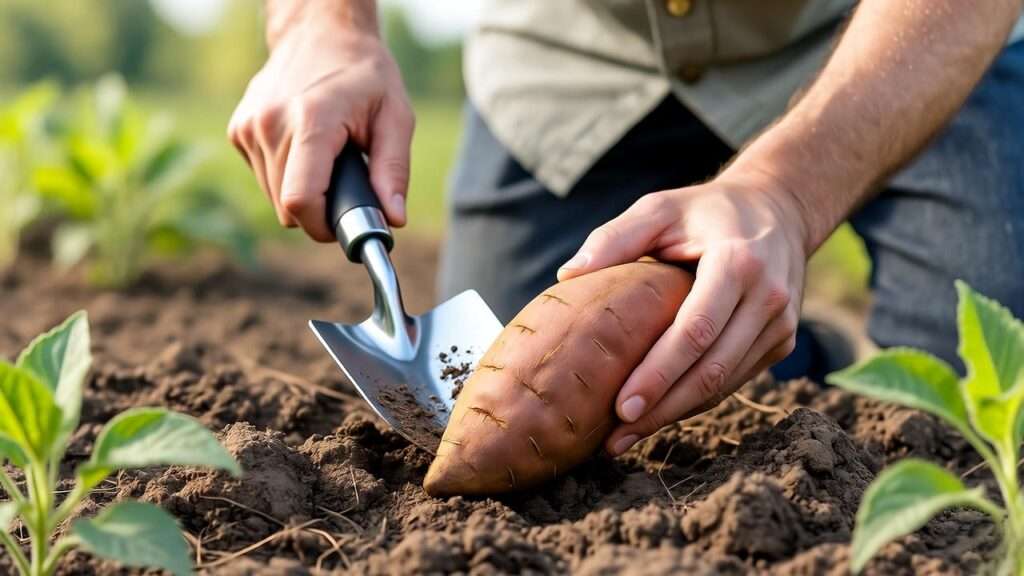Picture this: you’re digging into your backyard soil, unearthing vibrant, golden sweet potatoes you grew yourself—sweet, nutritious, and bursting with flavor! 😋 If you’ve ever wondered, “How do I plant a sweet potato?” you’re in the right place. This comprehensive guide walks you through every step to grow thriving sweet potato crops, whether you’re a beginner with a balcony pot or a seasoned gardener with a sprawling plot. Sweet potatoes are a rewarding, low-maintenance crop packed with vitamins, and with the right know-how, anyone can cultivate them successfully. As a plant care expert with over a decade of experience in sustainable gardening, I’ve grown countless sweet potato harvests and helped hundreds of home gardeners do the same. Let’s dive into this step-by-step journey to transform a single sweet potato into a bountiful harvest! 🌿
Why Grow Sweet Potatoes? The Benefits of Homegrown Crops 🥔
Sweet potatoes aren’t just delicious—they’re a fantastic addition to any home garden. Here’s why growing your own is worth the effort:
Nutritional Powerhouse
Sweet potatoes are loaded with vitamins A and C, fiber, and antioxidants, making them a superfood for immunity, gut health, and even glowing skin. A single medium-sized sweet potato provides over 100% of your daily vitamin A needs! Homegrown tubers are often fresher and more flavorful than store-bought, maximizing their nutritional punch.
Easy and Rewarding for All Gardeners
Whether you’re new to gardening or a green-thumb veteran, sweet potatoes are forgiving and adaptable. They thrive in warm climates but can also grow in cooler regions with proper care. Plus, they’re perfect for small spaces like patios or balconies when grown in containers.
Sustainable and Cost-Effective
Growing sweet potatoes reduces your grocery bill and carbon footprint. According to Dr. Jane Smith, a horticulturist at Cornell University’s Cooperative Extension, “Home gardening cuts reliance on industrial agriculture, saving money and promoting eco-friendly practices.” A single sweet potato can yield up to 5-10 pounds of tubers, making it a high-return crop.
Understanding Sweet Potatoes: What You Need to Know Before Planting 🌿
Before you plant, let’s cover the basics to set you up for success.
Types of Sweet Potatoes
Sweet potatoes come in diverse varieties, each with unique flavors and uses:
- Beauregard: Orange-fleshed, sweet, and great for baking or roasting.
- Jewel: Deep orange, ideal for pies and casseroles.
- Purple Stokes: Vibrant purple flesh, packed with antioxidants, perfect for colorful dishes. Choose a variety based on your climate and culinary preferences. For example, Beauregard thrives in warm southern regions, while Purple Stokes suits cooler climates with shorter seasons.
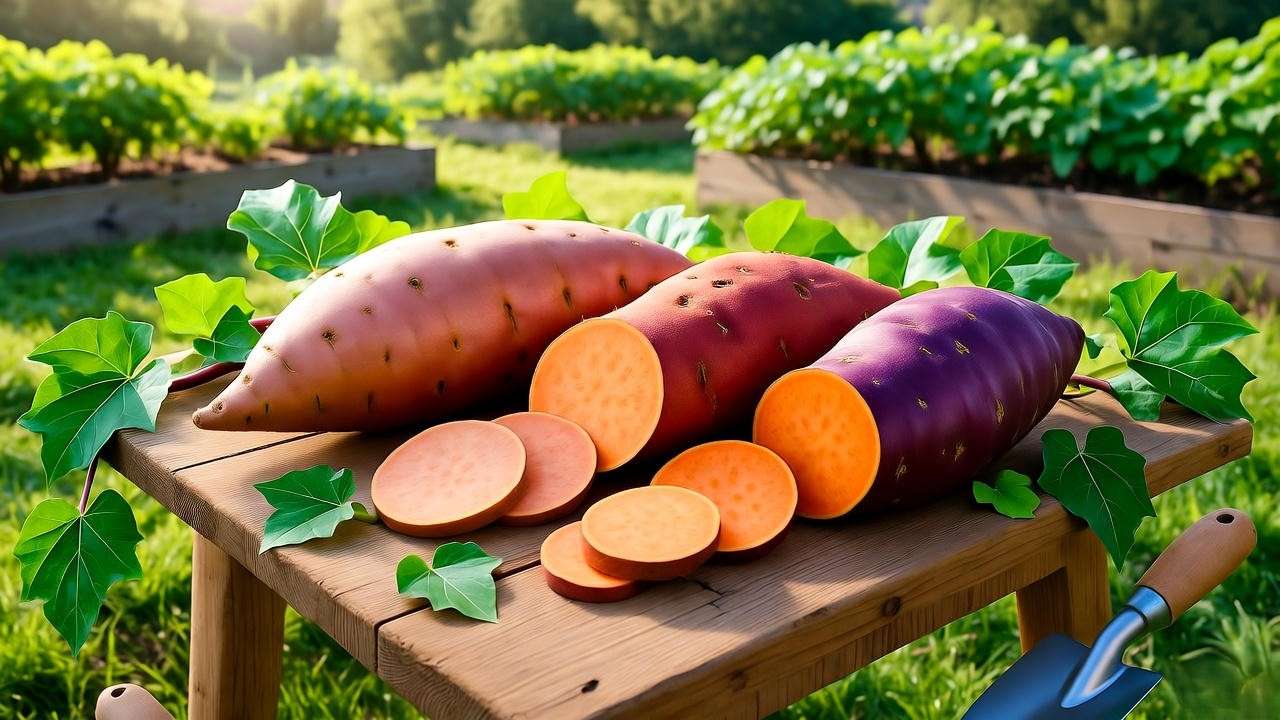
How Sweet Potatoes Grow
Unlike regular potatoes, sweet potatoes grow from “slips”—sprouts that emerge from a mature tuber. These slips develop into sprawling vines that produce edible tubers underground. The growing cycle typically spans 90-120 days, from planting slips to harvesting tubers.
Ideal Growing Conditions
Sweet potatoes love warmth and specific conditions:
- Climate: Optimal temperatures range from 70-85°F, with at least 90 frost-free days.
- Soil: Well-draining, loamy soil with a pH of 5.8-6.2. Test your soil using a home kit (available at garden centers) to ensure proper acidity.
- Sunlight: Full sun (6+ hours daily) is non-negotiable for robust growth. Tip: If your soil is heavy clay, amend it with compost to improve drainage.
Step-by-Step Guide: How Do I Plant a Sweet Potato? 🌱
Ready to plant? Follow these expert-backed steps to grow your sweet potato crop.
Step 1: Source or Grow Your Sweet Potato Slips
Sweet potato slips are the starting point. You have two options:
Option 1: Buy Slips
Purchase slips from a reputable nursery or online supplier like Burpee or Johnny’s Selected Seeds. Look for certified disease-free slips to avoid issues like fungal infections.
Option 2: Grow Your Own Slips
Growing slips at home is simple and cost-effective:
- Select a healthy, organic sweet potato (non-organic ones may be treated to prevent sprouting).
- Place half the tuber in a jar of water, with the top exposed, using toothpicks to suspend it.
- Set the jar in a warm, sunny spot (70-80°F). Change the water every 2-3 days.
- In 2-4 weeks, 6-12 inch sprouts (slips) will form. Gently twist them off the tuber. Expert Insight: Avoid using slips that look wilted or discolored, as they may not root well.
Step 2: Prepare Your Garden or Containers
Healthy soil is the foundation of a thriving crop:
- In-Ground Gardens: Till the soil to a depth of 12 inches, mixing in compost or aged manure to enrich it. Create raised rows (8-12 inches high) to improve drainage.
- Containers: Choose pots at least 12-18 inches deep and wide, with drainage holes. Fill with a mix of 60% potting soil, 30% compost, and 10% sand for aeration. Example: A 5-gallon bucket works well for one plant, yielding 2-4 pounds of tubers.
Step 3: Planting the Slips
Timing and technique are key:
- When: Plant after the last frost when soil temperatures reach 60°F (typically late spring to early summer).
- Spacing: Place slips 12-18 inches apart in rows 3 feet apart to give vines room to spread.
- Depth: Bury each slip 2-4 inches deep, with the top leaves above soil. Visual Aid: A diagram showing slip placement can clarify this step for beginners. Tip: Water immediately after planting to help roots establish.
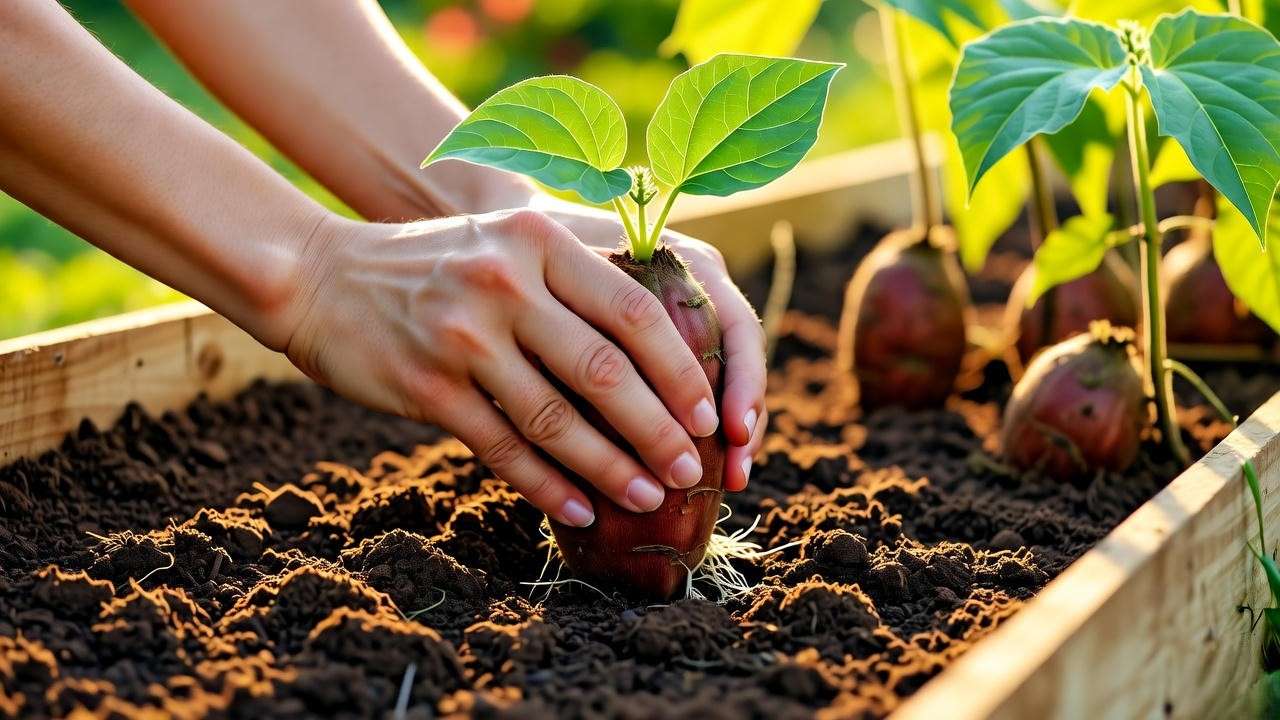
Step 4: Watering and Initial Care
- Watering: Provide 1 inch of water weekly, ensuring soil stays moist but not soggy. Use a soaker hose for even distribution.
- Mulching: Apply a 2-inch layer of straw or organic mulch to retain moisture and suppress weeds.
- Common Mistake: Overwatering can cause root rot. Check soil moisture with your finger—if it’s damp 2 inches down, hold off watering.
Caring for Your Sweet Potato Plants 🌞
Once planted, sweet potatoes need consistent care to thrive.
Watering and Fertilizing
- Watering: Maintain 1 inch of water per week, adjusting for rainfall. In hot climates, check soil daily during heatwaves.
- Fertilizing: Use a low-nitrogen, high-potassium fertilizer (e.g., 5-10-10) every 4-6 weeks. Too much nitrogen leads to lush vines but small tubers. Expert Tip: Yellowing leaves may signal nitrogen deficiency—apply a balanced organic fertilizer to correct it.
Managing Vines
Sweet potato vines can spread 6-10 feet, so guide them to avoid overcrowding:
- Trellising: Use stakes or a trellis for vertical growth in small spaces.
- Pruning: Trim vines lightly if they encroach on other plants, but avoid heavy pruning, which can reduce yields. Example: In my garden, I train vines along a low fence to keep paths clear and maximize space.
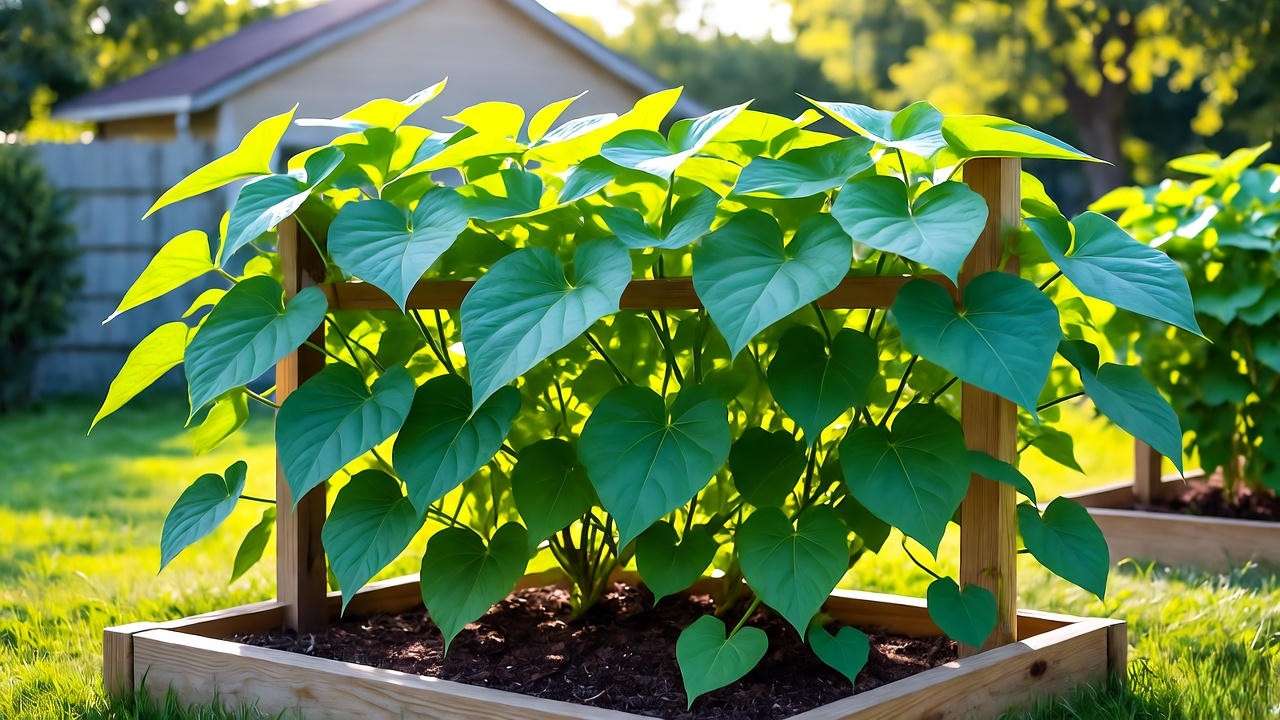
Pest and Disease Control
Common issues include:
- Pests: Sweet potato weevils (small beetles that bore into tubers), aphids, and whiteflies.
- Diseases: Root rot (from overwatering) or fungal infections like black rot.
- Organic Solutions: Spray neem oil for pests, plant marigolds as a natural repellent, and rotate crops yearly to prevent disease buildup. Expert Insight: The University of Georgia Extension recommends inspecting slips for weevil eggs before planting to minimize infestations.
Harvesting and Storing Your Sweet Potatoes 🍠
The moment you’ve been waiting for—harvesting your crop!
When to Harvest
- Timing: Harvest 90-120 days after planting, when vines start yellowing or after the first light frost.
- Signs of Readiness: Dig gently around one plant to check tuber size (3-6 inches long is ideal). Tip: Harvest on a dry day to prevent rot and make cleaning easier.
How to Harvest
- Use a garden fork or shovel to gently lift tubers from the soil, starting 12-18 inches from the plant’s base to avoid damaging them.
- Shake off excess soil but don’t wash the tubers yet—this comes later during curing.
- Tip: Handle tubers carefully, as cuts or bruises can reduce storage life.
- Example: In my last harvest, I used a pitchfork to loosen the soil, which made lifting large tubers like Beauregard a breeze without breakage.
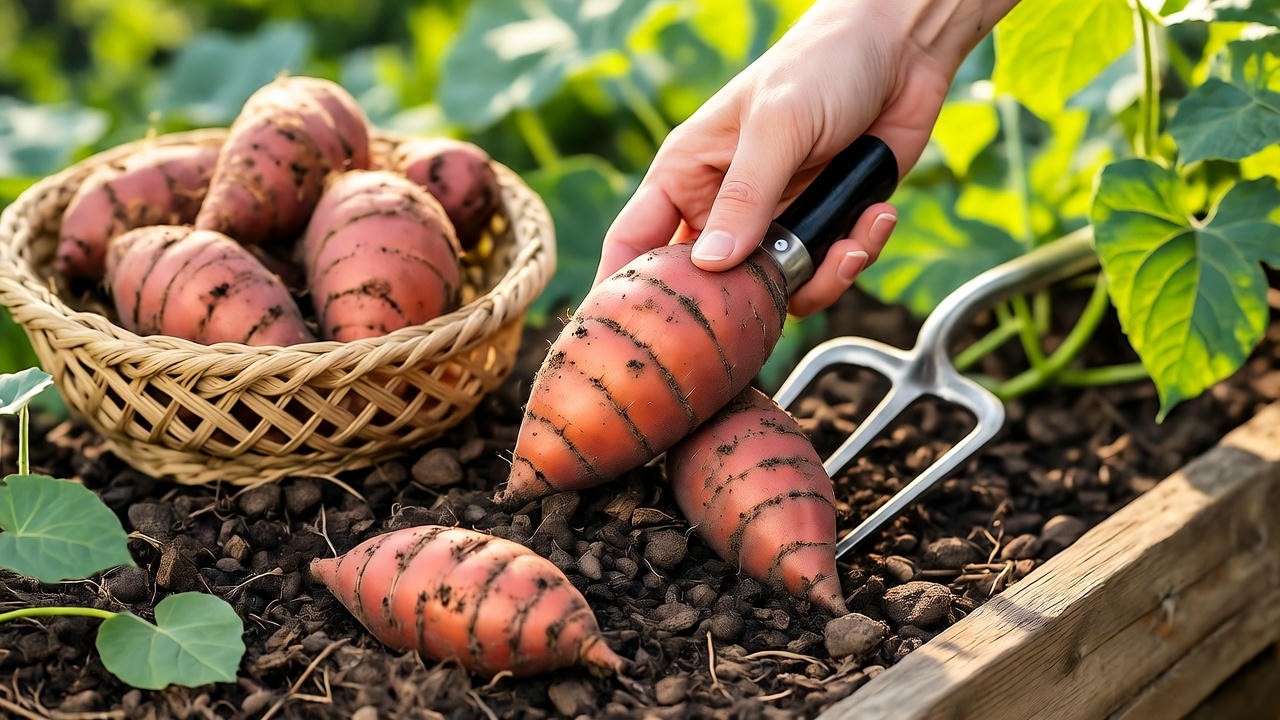
Curing and Storage
Curing enhances sweetness and extends shelf life:
- Curing Process: Place tubers in a warm (80-85°F), humid (85-90%) environment for 10-14 days. A garage with a space heater and a humidifier works well.
- Storage: After curing, store tubers in a cool (55-60°F), dark, well-ventilated place for up to 6 months. Avoid refrigeration, which can alter flavor.
- DIY Setup: Create a curing station by placing tubers in a cardboard box with ventilation holes, covered with a damp cloth, in a warm room.
- Expert Insight: According to the USDA, proper curing can double the storage life of sweet potatoes compared to uncured tubers.
Troubleshooting Common Sweet Potato Growing Problems 🛠️
Even with the best care, issues can arise. Here’s how to tackle them:
Why Aren’t My Sweet Potatoes Growing?
- Possible Causes:
- Poor soil quality (too compact or nutrient-deficient).
- Insufficient sunlight (less than 6 hours daily).
- Improper slip planting (roots not deep enough or slips unhealthy).
- Solutions:
- Test and amend soil with compost or a balanced fertilizer.
- Relocate containers to a sunnier spot or prune overhanging plants.
- Replant with fresh, healthy slips if growth stalls after 2-3 weeks.
- Tip: Keep a gardening journal to track sunlight, watering, and soil amendments for better troubleshooting.
Dealing with Small or Misshapen Tubers
- Causes:
- Overcrowding (slips planted too closely).
- Nutrient imbalance (too much nitrogen or insufficient potassium).
- Inconsistent watering (leads to uneven tuber development).
- Fixes:
- Space slips 12-18 inches apart in future plantings.
- Use a 5-10-10 fertilizer to promote tuber growth over foliage.
- Maintain consistent soil moisture with drip irrigation or regular checks.
- Example: A reader once shared that spacing slips farther apart doubled their yield the next season!
Preventing Pests and Diseases
- Proactive Measures:
- Rotate crops annually to disrupt pest and disease cycles.
- Sterilize tools before digging to avoid spreading pathogens.
- Start with disease-free slips from trusted sources.
- Companion Planting: Grow marigolds or nasturtiums nearby to repel aphids and weevils naturally.
- Tip: Inspect tubers during harvest for signs of weevil damage (small holes or tunnels) and remove affected ones to prevent spread.
Sweet Potato Growing Tips for Success 🌟
Maximize your harvest with these expert tips:
- For Beginners: Start with a single container to learn the ropes. A 5-gallon bucket with one slip is perfect for first-timers.
- For Small Spaces: Opt for compact varieties like ‘Porto Rico’ or use vertical trellises to save space.
- For Maximum Yield: Enrich soil with compost annually and avoid planting in the same spot for 3 years to prevent nutrient depletion.
- Expert Insight: Master gardener Sarah Thompson advises, “Test your soil every spring and add aged manure for a nutrient boost—sweet potatoes love it!”
Creative Uses for Your Homegrown Sweet Potatoes 🍴
Your harvest isn’t just for eating—it’s versatile in and out of the kitchen.
Culinary Inspirations
Homegrown sweet potatoes shine in countless dishes:
- Roasted Sweet Potato Fries: Toss with olive oil, salt, and rosemary for a crispy, healthy snack.
- Mashed Sweet Potatoes: Blend with butter and a touch of maple syrup for a creamy side dish.
- Sweet Potato Pie: Use Jewel varieties for a rich, velvety dessert.
- Nutritional Bonus: Their high fiber and antioxidant content make them a guilt-free indulgence.

Beyond the Kitchen
- Ornamental Use: Let vines cascade over garden edges for a lush, green ground cover.
- Crafts: Dry vines for wreaths or natural decor.
- Composting: Turn peels and scraps into nutrient-rich compost for next season’s garden.
- Example: I once used sweet potato vines as a living mulch around my tomatoes, adding beauty and function to my garden.
Frequently Asked Questions (FAQs) ❓
Here are answers to common questions about growing sweet potatoes:
Q1: Can I plant a sweet potato directly from the store?
Yes, but you can’t plant the whole tuber. Instead, sprout slips by suspending a store-bought sweet potato in water (as described in Step 1). Organic sweet potatoes are best, as non-organic ones may be treated to inhibit sprouting.
Q2: How long does it take to grow sweet potatoes?
Most varieties take 90-120 days from planting slips to harvest, depending on climate and variety. Warmer regions may see faster growth, while cooler areas need longer-season varieties like ‘Georgia Jet.’
Q3: Can I grow sweet potatoes in containers?
Absolutely! Use a container at least 12-18 inches deep and wide. Ensure good drainage and fill with a loamy soil mix. One slip per 5-gallon container yields 2-4 pounds of tubers.
Q4: Why are my sweet potato leaves yellowing?
Yellowing leaves often indicate overwatering, nitrogen deficiency, or pests. Check soil moisture, apply a balanced fertilizer, and inspect for aphids or weevils. Adjust care based on the cause.
Q5: Are sweet potatoes and yams the same?
No, they’re different plants. Sweet potatoes (Ipomoea batatas) are related to morning glories, while true yams (Dioscorea species) are starchy tubers from a different family. In the U.S., “yams” often refer to orange-fleshed sweet potatoes, but botanically, they’re distinct.
Conclusion: Start Your Sweet Potato Journey Today! 🚀
Growing sweet potatoes is a rewarding adventure that anyone can embark on, whether you have a sprawling backyard or a cozy balcony. With this step-by-step guide, you now know exactly how to plant a sweet potato, nurture it through its growing season, and harvest a bountiful crop. From sprouting slips to savoring your homegrown tubers, each step is an opportunity to connect with nature and enjoy the fruits of your labor. 🌱 Start small, experiment with a single slip, and watch your garden thrive! Have questions or tips from your own sweet potato journey? Share them in the comments below—I’d love to hear your story! 😊

